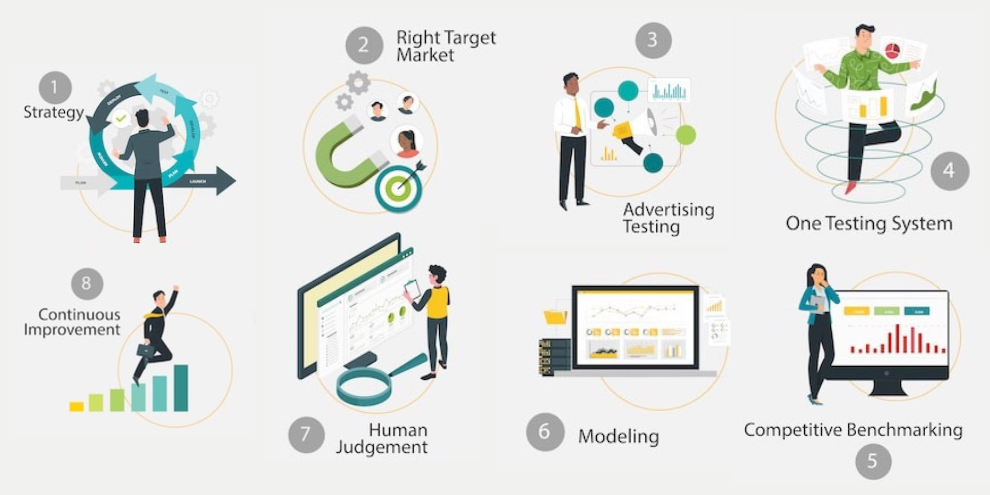Eight steps to creating better advertising
By Jerry W. Thomas, President and CEO, Decision Analyst
Advertising is all about changing human behavior. It’s a powerful tool, if used properly, to persuade people to think and act differently. Advertising can be used to achieve evil ends but it can also be used to pursue noble purposes and great causes. For example, advertising can encourage us to drink alcohol responsibly, buckle our seatbelts, drive within the speed limit or go vote. Advertising can also suggest that we eat more chicken and buy more peanut butter. In the hands of skillful marketing executives and expert researchers, the promise of advertising is the power to change the world.
Advertising can:
- build brand awareness
- set the consumer’s mental agenda (what they think about)
- communicate facts and information
- change behavior through the power of suggestion
- evoke strong emotions and link those emotions to the brand
- create a model or ideal that consumers choose to identify with
So, how can a client, advertising agency and research agency work together to create effective advertising?
1. Strategy
Sound strategy, based on facts and evidence, is essential to the creation of effective advertising. Good upfront research plays a crucial role in identifying strategy possibilities. Positioning and messaging concepts can be tested among target audiences to create a map, or a blueprint, for a brand’s advertising. Strategy concepts should be developed and tested before any advertising is created.
2. The right target market
Targeting is a key element of strategy and deciding who to target is not a simple matter. Identification of an optimal target market can be determined as a byproduct of strategy concept testing. Who is responding most positively to the winning strategy concepts? We have seen great advertising campaigns fail because they were aimed at the wrong audience.
3. Advertising testing
It’s best to test new creative at the storyboard or animatic stage (i.e., the rough stage) and at the final production stage. Early-stage testing allows rough commercials to be tweaked and fine-tuned before you spend the big dollars on final production. Testing the finished commercials gives you extra assurance that your advertising is on strategy and working. Testing also provides the diagnostics to help your creative team take a marginal commercial and edit it into a much stronger one. Testing (or pre-testing, as it’s sometimes called) is the feedback loop that leads to constant improvement.
4. One testing system
Use the same testing system consistently. There is no perfect advertising testing system. Some are better than others, but any system will help improve your advertising. The secret is for everyone to learn a testing system so that they fully understand how to interpret the results. The better everyone understands how the system works, the better advertising will become in the long run.
5. Competitive benchmarking
General normative databases are not good benchmarks to evaluate your advertising. Norms tend to be too low a bar because normative data contains many failed commercials. The long-term objective is evolving action standards. One way to develop good action standards is competitive benchmarking. Test your major competitors’ commercials so you can make sure your advertising is better. Through this type of competitive benchmarking, you can begin to develop good action standards (i.e., test scores that will lead to increased sales).
6. Modeling
Use a mathematical model or scoring system that takes multiple measures into account and derives an overall score for each ad execution. It doesn’t matter that an ad has great persuasion if it does not register the brand name. It doesn’t matter that an ad registers the brand name if no one notices the commercial itself. An ad must attract attention, register the brand name, communicate core messages and/or images and create interest in buying the brand. Advertising must do multiple things to be effective. All the key variables must be put together intelligently to come up with a composite model of advertising effectiveness.
7. Human judgment
Look at all the ad-testing results holistically. Review the research findings in relation to the objectives of your marketing plan. Read the open-ended questions and study the diagnostics so that, even if a commercial fails, you are learning how to make the next one better. Take all the survey questions and results, as well as marketing variables and competitive conditions, into account. Don’t blindly accept the test results. Informed human judgment remains important.
8. Continuous improvement
Clients and agencies need to accept that continuous advertising improvement is the goal. Advertising creative executions should be tweaked and refined based on pre-testing feedback to make sure they are on strategy. Repeated ad pre-testing provides a powerful feedback loop so that a brand’s advertising can become better and better over time. If a company and its agency pay close attention to the ad-testing results, advertising can become a powerful platform for long-term brand growth.
Good advertising is extremely powerful, and long-term continuity of on-strategy advertising maximizes its power. We have seen brands transformed through great advertising. We have seen companies destroyed through poor advertising. Short-term advertising works by building awareness, educating and setting the agenda. It works long-term by projecting a brand image and attaching strong emotions to the brand. The potential and promise of good advertising should never be underestimated.
www.decisionanalyst.com
jthomas@decisionanalyst.com
1-817-640-6166



